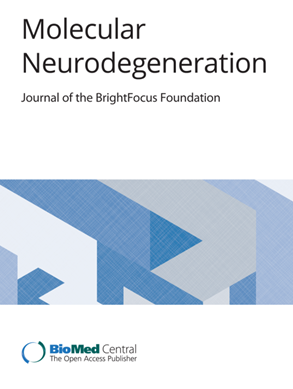Biophysical mapping of TREM2-ligand interactions reveals shared surfaces for engagement of multiple Alzheimer’s disease ligands
IF 14.9
1区 医学
Q1 NEUROSCIENCES
引用次数: 0
Abstract
TREM2 is a signaling receptor expressed on microglia that has emerged as an important drug target for Alzheimer’s disease and other neurodegenerative diseases. While a number of TREM2 ligands have been identified, little is known regarding the structural details of how they engage. To better understand this, we created a protein library of 28 different TREM2 variants that could be used to map interactions with various ligands using biolayer interferometry. The variants are located in previously identified putative binding surfaces on TREM2 called the hydrophobic site, basic site, and site 2. We found that mutations to the hydrophobic site ablated binding to apoE4 and TDP-43. Competition binding experiments indicated that apoE4 and oAβ42 share overlapping binding sites on TREM2. In contrast, binding to C1q was disrupted most strongly by mutations to the basic site, including R46, with some mutations to the hydrophobic site also attenuating binding, thus suggesting a broader mediation of binding across the two sites. Supporting this, competition experiments indicated that C1q binding could be blocked by both apoE and oAβ42. TREM2 binding to IL-34 was mediated by the basic site at a surface centering on R76. Competition binding experiments validated the unique site for IL-34, showing little to no competition with either oAβ42 or apoE4. However, competition experiments between C1q and IL34 suggest that the ligands compete for binding at the basic site. Altogether, our results suggest that TREM2 utilizes the hydrophobic site (consisting of CDR1, CDR2, and CDR3) as a common site to engage multiple ligands, and uses distinct basic sites to engage others. Our findings imply that pharmaceutical strategies targeting these surfaces might be effective to modulate TREM2 functions.trem2配体相互作用的生物物理图谱揭示了多种阿尔茨海默病配体参与的共享表面
TREM2是一种表达于小胶质细胞的信号受体,已成为阿尔茨海默病和其他神经退行性疾病的重要药物靶点。虽然已经确定了许多TREM2配体,但对它们如何参与的结构细节知之甚少。为了更好地理解这一点,我们创建了一个包含28种不同TREM2变体的蛋白质文库,可用于使用生物层干涉测量法绘制与各种配体的相互作用。这些变异位于先前确定的TREM2的假定结合表面,称为疏水位点、碱性位点和位点2。我们发现疏水位点的突变破坏了与apoE4和TDP-43的结合。竞争结合实验表明,apoE4和oAβ42在TREM2上有重叠的结合位点。相比之下,与C1q的结合受到包括R46在内的基本位点突变的最强烈破坏,疏水位点的一些突变也减弱了结合,从而表明在两个位点之间的结合具有更广泛的中介作用。竞争实验表明,apoE和oa - β42都可以阻断C1q的结合。tre2与IL-34的结合是通过以R76为中心的表面基位介导的。竞争结合实验验证了IL-34的独特位点,显示与oAβ42或apoE4几乎没有竞争。然而,C1q和IL34之间的竞争实验表明,这些配体在基本位点竞争结合。总之,我们的研究结果表明,TREM2利用疏水位点(由CDR1、CDR2和CDR3组成)作为一个共同位点与多个配体结合,并使用不同的基本位点与其他配体结合。我们的研究结果表明,针对这些表面的药物策略可能有效地调节TREM2的功能。
本文章由计算机程序翻译,如有差异,请以英文原文为准。
求助全文
约1分钟内获得全文
求助全文
来源期刊

Molecular Neurodegeneration
医学-神经科学
CiteScore
23.00
自引率
4.60%
发文量
78
审稿时长
6-12 weeks
期刊介绍:
Molecular Neurodegeneration, an open-access, peer-reviewed journal, comprehensively covers neurodegeneration research at the molecular and cellular levels.
Neurodegenerative diseases, such as Alzheimer's, Parkinson's, Huntington's, and prion diseases, fall under its purview. These disorders, often linked to advanced aging and characterized by varying degrees of dementia, pose a significant public health concern with the growing aging population. Recent strides in understanding the molecular and cellular mechanisms of these neurodegenerative disorders offer valuable insights into their pathogenesis.
 求助内容:
求助内容: 应助结果提醒方式:
应助结果提醒方式:


